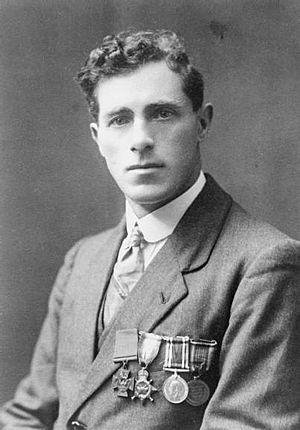Horace Augustus Curtis facts for kids
Quick facts for kids
Horace Augustus Curtis
VC
|
|
|---|---|
 |
|
| Born | 7 March 1891 St Anthony-in-Roseland, Cornwall |
| Died | 1 July 1968 (aged 77) Redruth, Cornwall |
| Allegiance | |
| Service/ |
|
| Years of service | 1914 - 1923 |
| Rank | Company Sergeant Major |
| Unit | The Duke of Cornwall's Light Infantry The Royal Dublin Fusiliers |
| Battles/wars | World War I |
| Awards | |
Horace Augustus Curtis was a very brave soldier from England. He was born on March 7, 1891, and passed away on July 1, 1968. He received the Victoria Cross, which is the highest award for bravery a soldier can get in the United Kingdom and Commonwealth countries. It is given for amazing courage when facing the enemy.
Contents
Serving in World War I
Horace Curtis was a soldier during World War I. He served in different places between 1915 and 1928.
- First, he was part of the Mediterranean Expeditionary Force.
- Then, he joined the Egyptian Expeditionary Force.
- Finally, he served with the British Expeditionary Force in France and Belgium.
In June 1918, Curtis returned to England. He went to a hospital in London to get treatment for malaria. He also got to go home for a short break. This was his first time home in four years! By September, he was back in France and ready to rejoin the fighting.
His Victoria Cross Action
On October 18, 1918, Sergeant Curtis showed incredible bravery near a place called Le Cateau. This is how he earned his Victoria Cross.
His group of soldiers suddenly came under heavy machine-gun fire. Curtis quickly realized that their attack would fail if the enemy guns kept firing. Without waiting, he bravely ran forward. He went through his own side's gunfire and the enemy's bullets. He managed to kill or wound the soldiers operating two of the machine guns. Because of this, the other four enemy guns gave up!
Then, Curtis noticed a train full of enemy soldiers arriving as reinforcements. He quickly acted and managed to capture over 100 enemy soldiers all by himself, before his own comrades could even reach him. His amazing courage and willingness to face danger inspired everyone around him.
The official story of his brave act was published on January 6, 1919.
No.14107 Sjt. Horace Augustus Curtis.2nd Battalion, R. Dub. Fus (Newlyn East, Cornwall)
For most conspicuous bravery and devotion to duty East of Le Cateau on the morning of 18th October 1918, when in attack his platoon came unexpectedly under intense machine-gun fire. Realising that the attack would fail unless the enemy guns were silenced, Sjt Curtis, without hesitation, rushed forward through our own barrage and the enemy fire and killed and wounded the teams of two of the guns, whereupon the remaining four guns surrendered. Then turning his attention to a train-load of reinforcements, he succeeded in capturing over 100 enemy before his comrades joined him. His valour and disregard of danger inspired all.
King George V personally gave Horace Curtis his Victoria Cross medal. This special ceremony happened at Buckingham Palace on March 8, 1919.
What Happened After the War?
Horace Curtis left the army on March 31, 1920. He then joined a local army unit called the 5th (Territorial) Battalion DCLI. He quickly moved up in rank to Sergeant. He continued to serve for a few more years before ending his service in May 1923.
Horace Augustus Curtis passed away on July 1, 1968.
Where to See His Medal
Horace Curtis's Victoria Cross medal is a very important historical item. You can see it on display at the Lord Ashcroft Collection. This collection is located at the Imperial War Museum in London.

